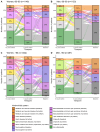Trajectories of chronic multimorbidity patterns in older patients: MTOP study
- PMID: 38816787
- PMCID: PMC11137950
- DOI: 10.1186/s12877-024-04925-2
Trajectories of chronic multimorbidity patterns in older patients: MTOP study
Abstract
Background: Multimorbidity is associated with negative results and poses difficulties in clinical management. New methodological approaches are emerging based on the hypothesis that chronic conditions are non-randomly associated forming multimorbidity patterns. However, there are few longitudinal studies of these patterns, which could allow for better preventive strategies and healthcare planning. The objective of the MTOP (Multimorbidity Trajectories in Older Patients) study is to identify patterns of chronic multimorbidity in a cohort of older patients and their progression and trajectories in the previous 10 years.
Methods: A retrospective, observational study with a cohort of 3988 patients aged > 65 was conducted, including suspected and confirmed COVID-19 patients in the reference area of Parc Taulí University Hospital. Real-world data on socio-demographic and diagnostic variables were retrieved. Multimorbidity patterns of chronic conditions were identified with fuzzy c-means cluster analysis. Trajectories of each patient were established along three time points (baseline, 5 years before, 10 years before). Descriptive statistics were performed together with a stratification by sex and age group.
Results: 3988 patients aged over 65 were included (58.9% females). Patients with ≥ 2 chronic conditions changed from 73.6 to 98.3% in the 10-year range of the study. Six clusters of chronic multimorbidity were identified 10 years before baseline, whereas five clusters were identified at both 5 years before and at baseline. Three clusters were consistently identified in all time points (Metabolic and vascular disease, Musculoskeletal and chronic pain syndrome, Unspecific); three clusters were only present at the earliest time point (Male-predominant diseases, Minor conditions and sensory impairment, Lipid metabolism disorders) and two clusters emerged 5 years before baseline and remained (Heart diseases and Neurocognitive). Sex and age stratification showed different distribution in cluster prevalence and trajectories.
Conclusions: In a cohort of older patients, we were able to identify multimorbidity patterns of chronic conditions and describe their individual trajectories in the previous 10 years. Our results suggest that taking these trajectories into consideration might improve decisions in clinical management and healthcare planning.
Trial registration number: NCT05717309.
Keywords: Ageing; Chronic conditions; Cluster analysis; Longitudinal study; Multimorbidity; Older patients; Trajectories.
© 2024. The Author(s).
Conflict of interest statement
The authors declare no competing interests.
Figures


Similar articles
-
Multimorbidity patterns and trajectories in young and middle-aged adults: a large-scale population-based cohort study.Front Public Health. 2024 May 16;12:1349723. doi: 10.3389/fpubh.2024.1349723. eCollection 2024. Front Public Health. 2024. PMID: 38818448 Free PMC article.
-
Multimorbidity patterns of chronic conditions and geriatric syndromes in older patients from the MoPIM multicentre cohort study.BMJ Open. 2021 Nov 15;11(11):e049334. doi: 10.1136/bmjopen-2021-049334. BMJ Open. 2021. PMID: 34782339 Free PMC article.
-
Multimorbidity patterns in the elderly: a prospective cohort study with cluster analysis.BMC Geriatr. 2018 Jan 16;18(1):16. doi: 10.1186/s12877-018-0705-7. BMC Geriatr. 2018. PMID: 29338690 Free PMC article.
-
Studying trajectories of multimorbidity: a systematic scoping review of longitudinal approaches and evidence.BMJ Open. 2021 Nov 22;11(11):e048485. doi: 10.1136/bmjopen-2020-048485. BMJ Open. 2021. PMID: 34810182 Free PMC article.
-
Description of multimorbidity clusters of admitted patients in medical departments of a general hospital.Postgrad Med J. 2022 Apr;98(1158):294-299. doi: 10.1136/postgradmedj-2020-139361. Epub 2021 Feb 5. Postgrad Med J. 2022. PMID: 33547138 Review.
Cited by
-
Charting the Pathways of Cardiometabolic Multimorbidity: A Systematic Review of Clinical Trajectories.J Clin Med. 2025 Apr 11;14(8):2615. doi: 10.3390/jcm14082615. J Clin Med. 2025. PMID: 40283445 Free PMC article. Review.
-
Associations of cardiometabolic multimorbidity with all-cause dementia, alzheimer's disease, and vascular dementia: a cohort study in the UK biobank.BMC Public Health. 2025 Jul 7;25(1):2397. doi: 10.1186/s12889-025-23352-5. BMC Public Health. 2025. PMID: 40624483 Free PMC article.
-
Identifying clusters of multimorbid disease and differences by age, sex, and socioeconomic status: A systematic review.PLoS One. 2025 Aug 22;20(8):e0329794. doi: 10.1371/journal.pone.0329794. eCollection 2025. PLoS One. 2025. PMID: 40845048 Free PMC article. Review.
References
-
- World Health Organization. Ageing and health. 2022. https://www.who.int/news-room/fact-sheets/detail/ageing-and-health. Accessed 19 May 2023.
-
- Publications Office of the European Union. Ageing Europe - Looking at the lives of older people in the EU– 2020 edition. Luxembourg; 2020.
Publication types
MeSH terms
Associated data
Grants and funding
LinkOut - more resources
Full Text Sources
Medical

